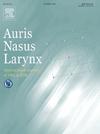Differential diagnosis of skull base osteomyelitis from malignancies focusing on the radiological features on HRCT
IF 1.5
4区 医学
Q2 OTORHINOLARYNGOLOGY
引用次数: 0
Abstract
Objective
Skull base osteomyelitis (SBO) is a rare but life-threatening inflammatory disease often misdiagnosed as a malignancy, such as nasopharyngeal carcinoma (NPC) and external auditory canal cancer (EACC), due to extensive bone destruction. This study aimed to identify the radiological features of SBO using high-resolution CT, which could help in the differential diagnosis of malignancies.
Methods
High-resolution CT findings of 14 patients with SBO, 25 with NPC, and 19 with EACC were retrospectively reviewed. Abnormal findings at seven sites: 1) external auditory canal, 2) mastoid portion, 3) petrous portion of the temporal bone, 4) clivus, 5) jugular foramen, 6) nasopharyngeal soft tissue thickness, and 7) torus tubarius shape were compared among the patient groups on axial slice of HRCT.
Results
When comparing SBO and NPC, there were significant differences in sites 1) (p = 0.0001), 3) (p = 0.0064), 5), and 7) (p < 0.0001); among them, the most specific finding was the site 7). When comparing SBO and EACC, there were significant differences in sites 1) (p = 0.0084), 3) (p < 0.0001), 4) (p = 0.0013), 5) (p = 0.0015), and 6) (p < 0.0001); among them, the most specific finding was cortical bone destruction in site 3).
Conclusion
Our findings indicated that the bilateral preservation of “μ-shape sign” in the torus tubarius and bone destruction in the petrous portion on HRCT were the most specific signs differentiating SBO from NPC and EACC, respectively. Knowledge of these features can contribute to prompt diagnosis and treatment of SBO.
颅底骨髓炎与恶性肿瘤的鉴别诊断重点在于HRCT的影像学特征
目的颅底骨髓炎(SBO)是一种罕见但危及生命的炎症性疾病,由于其广泛的骨破坏,常被误诊为恶性肿瘤,如鼻咽癌(NPC)和外耳道癌(EACC)。本研究旨在利用高分辨率CT识别SBO的放射学特征,以帮助恶性肿瘤的鉴别诊断。方法回顾性分析14例SBO、25例NPC、19例EACC的高分辨率CT表现。比较两组患者HRCT轴位片在1)外耳道、2)乳突部分、3)颞骨岩部、4)斜坡、5)颈静脉孔、6)鼻咽部软组织厚度、7)管环体形状等7个部位的异常表现。结果SBO与NPC比较,1)(p = 0.0001)、3)(p = 0.0064)、5)、7)位点(p <;0.0001);其中,最具体的发现是地点。SBO与EACC比较,1)(p = 0.0084)、3)(p <;0.0001), 4) (p = 0.0013), 5) (p = 0.0015), 6) (p & lt;0.0001);其中,最具体的发现是3)处皮质骨破坏。结论HRCT上双侧管环部“μ形征”保留和岩部骨破坏是区分SBO与鼻咽癌和EACC最特异的征象。了解这些特征有助于SBO的及时诊断和治疗。
本文章由计算机程序翻译,如有差异,请以英文原文为准。
求助全文
约1分钟内获得全文
求助全文
来源期刊

Auris Nasus Larynx
医学-耳鼻喉科学
CiteScore
3.40
自引率
5.90%
发文量
169
审稿时长
30 days
期刊介绍:
The international journal Auris Nasus Larynx provides the opportunity for rapid, carefully reviewed publications concerning the fundamental and clinical aspects of otorhinolaryngology and related fields. This includes otology, neurotology, bronchoesophagology, laryngology, rhinology, allergology, head and neck medicine and oncologic surgery, maxillofacial and plastic surgery, audiology, speech science.
Original papers, short communications and original case reports can be submitted. Reviews on recent developments are invited regularly and Letters to the Editor commenting on papers or any aspect of Auris Nasus Larynx are welcomed.
Founded in 1973 and previously published by the Society for Promotion of International Otorhinolaryngology, the journal is now the official English-language journal of the Oto-Rhino-Laryngological Society of Japan, Inc. The aim of its new international Editorial Board is to make Auris Nasus Larynx an international forum for high quality research and clinical sciences.
 求助内容:
求助内容: 应助结果提醒方式:
应助结果提醒方式:


